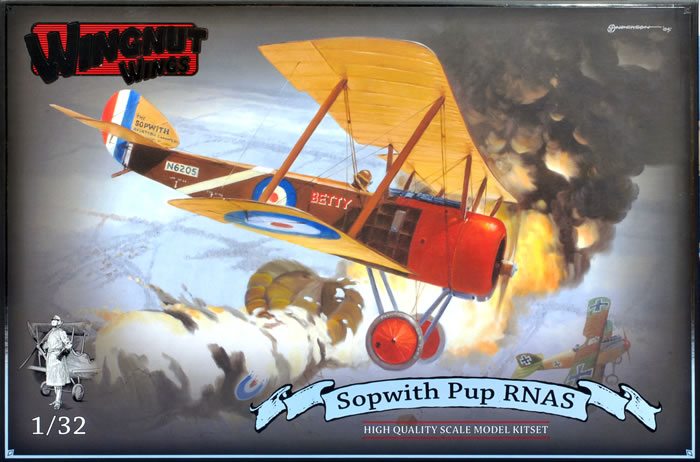Sopwith Pup RNAS

Wingnut Wings, 1/32 scale
S u m m a r y |
Catalogue Number: |
Wingnut Wings 32016 - Sopwith Pup RNAS |
Scale: |
1/32 |
Contents and Media: |
119 parts in grey injection moulded plastic; nine parts in clear; photo-etched fret; markings for six aircraft. |
Price: |
Available online from Mid-March exclusively from Wingnut Wings for USD$59.00.
Includes free international postage for a limited time |
Review Type: |
First Look |
Advantages: |
Cleverly engineered for ease of assembly; modest parts count (not intimidating); outstanding representation of fabric, tape and general surface detail; high quality mouldings with fine sprue attachments; comprehensive decal sheet in perfect register with minimal carrier film, photo-etched seat belts; full-colour instruction booklet doubles as a one-stop reference. |
Disadvantages: |
|
Conclusion: |
Wingnut Wings follows up its first batch of releases with another brilliant offering for WWI modellers. At USD$59.00, these kits represent oustanding value too. |
Reviewed by Brett Green

HyperScale is proudly supported by Squadron
In addition to its two Albatros kits, Wingnut Wings will be releasing two 1/32 scale Sopwith Pup kits in mid-March. This is the first time that we have seen an injection moulded Sopwith Pup kit in 1/32 scale.
This time, we will be taking a look at the RNAS (Royal Naval Air Service) Sopwith Pup, kit number 32016.
Wingnut Wings’ Sopwith Pup RNAS comprises 119 parts in grey injection moulded plastic, nine parts in clear, a photo-etched fret and markings for five interesting aircraft.
The kit features simply beautiful surface texture, including subtly stretched fabric, fine strips and stitching, crisply recessed panel lines and raised details where appropriate.
The modest parts count does not detract from Wingnut Wings' customary high level of detail in any way, but it will make this kit a good prospect for any anxious first-time WWII modellers.
Kit engineering is conventional and designed to make construction as painless as possible. Two complete fuselage halves are provided for the Type 9901 and Type 9901a.The upper wing is moulded in a single piece with separate ailerons, while the lower wings are presented as single left and right halves. An alternative upper wing is provided with the machine gun cutout for the shipboard Type 9901a.

The struts are all fitted with good-sized locating tabs that fit into corresponding holes in the wings. Locating positions are marked for rigging, which should be drilled out with a 0.5mm drill to a depth of at least 1mm if required.
In addition to their exterior detail, the fuselage halves are moulded with interior structures in place too. These will supplement the beautifully detailed cockpit, complete with framing, Vickers Gun magazine and empty belt winder. A detailed internal rigging diagram for the cockpit and control wires is also included for that extra air of authenticity. The instrument panel is adorned with individual authentic decal instruments.
The Le Rhone 80 hp engine will be straightforward to build but is well detailed, with push rods and exhausts supplied as plastic parts. The ignition hanress is not provided, but a diagram for placing the wires is offered in the instructions.
Two different propellers are supplied plus alternate machine gun armament, windscreens, forward cowls (Standard Motor Co. and Common) and side cowl hatches. The clear parts are thin and free from distortion.

Where optional parts are provided, the instructions direct the applicable marking options.
The photo-etched fret offers the wide harness straps, actuator and gun sight.

The 24 page instruction booklet is presented in the same format as its predecessors, with 3D construction views supplemented by generous reference photos of wartime machines and detail shots of an authentic full-sized replica.
Marking Options
Six marking options are provided.

The large decal sheet isprinted by Cartograf. They are brightly coloured with perfect register and thin surrounds. Stencil markings along with the aforementioned instruments accompany the unique aircraft decals.

All six marking options feature upper surfaces in PC10 and lowers in Clear Doped Linen. Variety is provided by three schemes with bare metal cowls (one with a red fin), another in black, and the other two in red. The final option features a high fuselage demarcation. The fuselage sides on this one are finished in Clear Doped Linen rather than the more familiar PC10.
Wingnut Wings 1/32 scale Sopwith Pup clearly demonstrates that this new company intends to maintain and even improve on its impressive first efforts.
This Pup is beautifully detailed and should be eminently buildable thanks to its clever engineering and modest parts count. This will be a terrific starting point for modellers wishing to try their hand at their first 1/32 scale WWI biplane.
Thanks to Wingnut Wings for the review sample.
Review Text and Images Copyright © 2010 by Brett Green
Page Created 23 February, 2010
Last updated
23 February, 2010
Back to HyperScale Main Page

|
